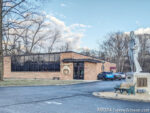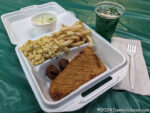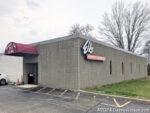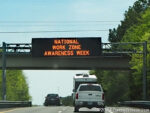 I knew long ago that I would be attending the 2024 Jefferson Highway Association Conference in Alexandria, LA, but only recently decided to also join the pre-conference sociability run. The first day of my expressway-centered drive to the start of the run had been posted and updates from the run and the conference will follow. The journal is here.
I knew long ago that I would be attending the 2024 Jefferson Highway Association Conference in Alexandria, LA, but only recently decided to also join the pre-conference sociability run. The first day of my expressway-centered drive to the start of the run had been posted and updates from the run and the conference will follow. The journal is here.
2024 Hollow Earth Fest
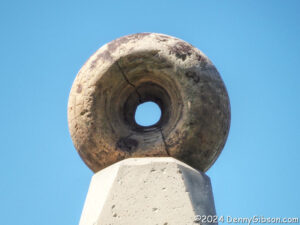 Once upon a time, in a land very very near, there lived a man who declared that the earth was hollow. Among the man’s disciples was his son who eventually erected a tombstone topped by a 3D representation of the earth with entrances to its interior at both poles. On Saturday, April 13, that marker was the focal point of the first-ever (AFAIK) Hollow Earth Fest.
Once upon a time, in a land very very near, there lived a man who declared that the earth was hollow. Among the man’s disciples was his son who eventually erected a tombstone topped by a 3D representation of the earth with entrances to its interior at both poles. On Saturday, April 13, that marker was the focal point of the first-ever (AFAIK) Hollow Earth Fest.
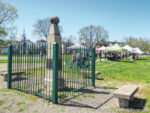 That very near land is southwest Ohio with the Hollow Earth Monument standing in the city of Hamilton. The man buried beneath it is John Cleves Symmes Jr., who served in the US Army during the War of 1812 before moving to Saint Louis, MO, then Newport, KY, and then Hamilton, OH. He was the nephew of a more famous John Cleves Symmes who fought in the Revolutionary War, served in the Continental Congress, and bought and resold a major chunk of southwest Ohio. The elder John Cleves Symmes had no male children. It was his nephew who was named after him with the “Jr.” suffix often used to distinguish the two.
That very near land is southwest Ohio with the Hollow Earth Monument standing in the city of Hamilton. The man buried beneath it is John Cleves Symmes Jr., who served in the US Army during the War of 1812 before moving to Saint Louis, MO, then Newport, KY, and then Hamilton, OH. He was the nephew of a more famous John Cleves Symmes who fought in the Revolutionary War, served in the Continental Congress, and bought and resold a major chunk of southwest Ohio. The elder John Cleves Symmes had no male children. It was his nephew who was named after him with the “Jr.” suffix often used to distinguish the two.
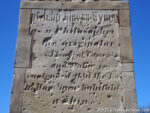 John Cleves Symmes Jr. died in 1829 at the age of 48 and was buried in the Pioneer Cemetery in Hamilton. When that cemetery was replaced by Greenwood Cemetery in 1848, his body was left behind for some reason. His son, Americus, erected the hollow earth marker in 1873.
John Cleves Symmes Jr. died in 1829 at the age of 48 and was buried in the Pioneer Cemetery in Hamilton. When that cemetery was replaced by Greenwood Cemetery in 1848, his body was left behind for some reason. His son, Americus, erected the hollow earth marker in 1873.
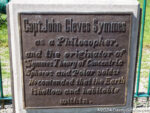

 The marker’s original carvings have become nearly unreadable and have been reproduced on metal plaques mounted on a pedestal below. The monument was rededicated in 1991 as noted by a fourth plaque on its otherwise blank side.
The marker’s original carvings have become nearly unreadable and have been reproduced on metal plaques mounted on a pedestal below. The monument was rededicated in 1991 as noted by a fourth plaque on its otherwise blank side.
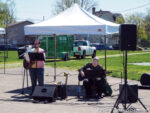
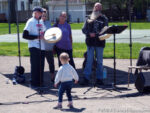
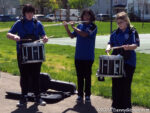 Music at the festival included a fife (or maybe flute) and drum trio, native American drummers and singers with spontaneous dancing in the audience, and a father-son duo.
Music at the festival included a fife (or maybe flute) and drum trio, native American drummers and singers with spontaneous dancing in the audience, and a father-son duo.

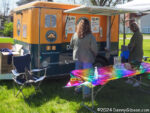 Food trucks and other vendors were present including Municipal Brew Works with a Belgian ale, Earth Donut, brewed especially for the occasion.
Food trucks and other vendors were present including Municipal Brew Works with a Belgian ale, Earth Donut, brewed especially for the occasion.
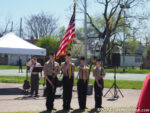
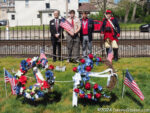
 There were also some more formal ceremonies and presentations but I did not do a very good job of documenting them. I can, however, show that the Daughters of the American Revolution, Sons of the American Revolution, and Boy Scouts of America were all represented.
There were also some more formal ceremonies and presentations but I did not do a very good job of documenting them. I can, however, show that the Daughters of the American Revolution, Sons of the American Revolution, and Boy Scouts of America were all represented.
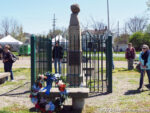 It goes without saying that this was absolutely the best Hollow Earth Fest that I have ever attended. It wasn’t huge but it had a blend of history, patriotism, civic pride, and debunked science that I can see leading to real growth in the future. It’s the sort of thing that people of all ages, from all walks of life, and from all over and within the globe can enjoy.
It goes without saying that this was absolutely the best Hollow Earth Fest that I have ever attended. It wasn’t huge but it had a blend of history, patriotism, civic pride, and debunked science that I can see leading to real growth in the future. It’s the sort of thing that people of all ages, from all walks of life, and from all over and within the globe can enjoy.
Book Review
UnStuck
Stephanie Stuckey
 I am more familiar with Stuckey’s signs than their products. As a kid, I probably didn’t even know the company existed since my family did not travel much. They were still going strong when I started doing some traveling on my own and I believe I bought gas at their stores a few times along with a pecan log roll or two but there was very little money in my travel budget for candy and none at all for rubber snakes. By the time my own fortunes had improved to the point that snacks were regularly permitted on road trips, Stuckey’s fortunes were headed in the other direction. The main reason that I am familiar with Stuckey’s signs is that I drove by a bunch of them. Many, maybe most, were for stores that were closed.
I am more familiar with Stuckey’s signs than their products. As a kid, I probably didn’t even know the company existed since my family did not travel much. They were still going strong when I started doing some traveling on my own and I believe I bought gas at their stores a few times along with a pecan log roll or two but there was very little money in my travel budget for candy and none at all for rubber snakes. By the time my own fortunes had improved to the point that snacks were regularly permitted on road trips, Stuckey’s fortunes were headed in the other direction. The main reason that I am familiar with Stuckey’s signs is that I drove by a bunch of them. Many, maybe most, were for stores that were closed.
I first became aware of Stuckey’s rebirth when friends in Indiana became resellers of the company’s products. I made a point of stocking up on pecan goodness when a couple of road trips had me passing nearby. One of those trips was to a conference where Stephanie Stuckey was speaking and where I met her briefly. I have been looking forward to this book’s publication since then and thought I had a good idea of the story it would tell. It turns out that I had the basic outline down reasonably well but I was missing a ton of details and there were some genuine surprises. There was even a mystery of sorts.
The first part of the story is not particularly unique. An ambitious and creative man builds a very successful business through hard work and the help of friends and family. At the height of the company’s success, he sells it to collect his well-deserved rewards. Plopped into the world of faceless corporations, the company survives but becomes faceless itself. It is a fairly common tale that usually continues with more decline and eventual disappearance. That’s where this story becomes different. It’s where it becomes worth reading. UnStuck is a well-written telling of the uncommon story of a third-generation’s retrieval of the family business.
William S. Stuckey, Stephanie’s grandfather, founded the company in 1937 and sold it (actually merged with Pet Milk Co.) in 1964. It remained a significant presence on the American roadside into the 1970s but corporate shuffling led to the brand’s serious decline before the decade was over. William S. Stuckey, Jr., Stephanie’s father, stopped the downward slide when he repurchased the company in 1984. Stephanie took over in 2019. Those are the bullet points on a company timeline with lots of space in between. UnStuck fills in much of that space with an understandable focus on the post-2019 years.
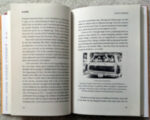 Stephanie’s father had great success in politics and served five terms in the U.S. Congress. She had her own success in politics with fourteen years in the Georgia state legislature. When Stephanie’s dad brought the company back to the family, he said it was based 80% on emotion and 20% on finances. There is little need to break Stephanie’s reasons for buying the company down by percentage. It was almost certainly 100% emotion. She had wonderful memories of her grandfather and road trips that included stops at stores bearing the family name. I have little doubt that a sizable percentage of the emotion behind the purchase was pure nostalgia.
Stephanie’s father had great success in politics and served five terms in the U.S. Congress. She had her own success in politics with fourteen years in the Georgia state legislature. When Stephanie’s dad brought the company back to the family, he said it was based 80% on emotion and 20% on finances. There is little need to break Stephanie’s reasons for buying the company down by percentage. It was almost certainly 100% emotion. She had wonderful memories of her grandfather and road trips that included stops at stores bearing the family name. I have little doubt that a sizable percentage of the emotion behind the purchase was pure nostalgia.
Stephanie’s grandfather was known within the family as Bigdaddy. Six boxes of Bigdaddy’s papers play a very big role in Unstuck‘s story. How the new CEO studied spreadsheets and packed aging inventory into Mystery Boxes to return the company to profitability is interesting but it was what she learned from those papers that would let her move beyond that. They gave her some insight into how Bigdaddy viewed Stuckey’s, the company, and how he attacked problems. She cites his “two lessons in resilience — surviving World War II and the bypassing of his stores.”
 I and many other fans of old roads are conflicted about the interstate highways. We appreciate their ability to make travel faster and safer but regret the damage done to small businesses in the towns they bypassed. Stuckey’s was not exactly a small business at the time the interstates appeared but it did depend on traffic through those towns. Bigdaddy used the upheaval as an opportunity to redesign and relocate his stores and establish a partnership with Texaco that made those stores “a one-stop shop”. The papers in those boxes did not provide specific answers to any of the company’s problems but they did reveal and encourage a truly open-minded way of looking at them.
I and many other fans of old roads are conflicted about the interstate highways. We appreciate their ability to make travel faster and safer but regret the damage done to small businesses in the towns they bypassed. Stuckey’s was not exactly a small business at the time the interstates appeared but it did depend on traffic through those towns. Bigdaddy used the upheaval as an opportunity to redesign and relocate his stores and establish a partnership with Texaco that made those stores “a one-stop shop”. The papers in those boxes did not provide specific answers to any of the company’s problems but they did reveal and encourage a truly open-minded way of looking at them.
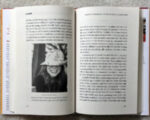 That open-mindedness may or may not have figured into a board meeting described in UnStuck where “brand identity” was discussed. Thinking that Stuckey’s is “all about pecan snacks and candies” might seem natural but some serious reflection said otherwise. Stephanie had been visiting many of the surviving Stuckey’s stores and licensees and sharing some of the details on social media as a form of free advertising. That generated some responses almost none of which were about snacks or candies. 99% of the stories people shared with her were about road trips that just happened to involve Stuckey’s in some way. Most of Stephanie’s own childhood memories of Stuckey’s came from road trips. People may know that Stuckey’s sells pecans but they identify the company with road trips! Despite my limited experience, I do too.
That open-mindedness may or may not have figured into a board meeting described in UnStuck where “brand identity” was discussed. Thinking that Stuckey’s is “all about pecan snacks and candies” might seem natural but some serious reflection said otherwise. Stephanie had been visiting many of the surviving Stuckey’s stores and licensees and sharing some of the details on social media as a form of free advertising. That generated some responses almost none of which were about snacks or candies. 99% of the stories people shared with her were about road trips that just happened to involve Stuckey’s in some way. Most of Stephanie’s own childhood memories of Stuckey’s came from road trips. People may know that Stuckey’s sells pecans but they identify the company with road trips! Despite my limited experience, I do too.
I mentioned a mystery of sorts. Maybe not everyone reads dedications but I usually do. At the very front of UnStuck, I read that it is dedicated to John King. I had no idea who John King was and eventually learned that when she started writing this book Stephanie Stuckey didn’t either. Among other things, John King appears with Bigdaddy in a photo featured in the Stuckey’s company’s 25th-anniversary newsletter. John King is Black. After considerable effort, Stephanie learned that her grandfather and John spent a lot of time together during the company’s early days but not much else. In particular, she found no evidence that he was ever rewarded for what appears to have been significant contributions. That was not an unusual situation in the South in the early twentieth century which is also something Stephanie addresses in the dedication. On the other hand, there are several references in the book to the fact that Stuckey’s was never segregated which was sometimes possible only because the stores were outside the official limits of sundown towns. It is something that many people remember about the chain to this day.
The prologue imagines William Sylvester Stuckey thinking to himself after a pecan stand customer calls him crazy, “But that’s what it’s going to take to make it.” Stephanie finds herself thinking the exact same thing when she considers that people might think her crazy for buying what she had recently referred to as a “dumpster fire of a business”. The book does talk about pecans somewhat. It explains that the name comes from pacane, an Algonquian word meaning “nut that’s hard to crack”. Guess it runs in the family.
UnStuck: Rebirth of an American Icon, Stephanie Stuckey, Matt Holt (April 2, 2024), 6.25 x 9.31 inches, 240 pages, ISBN 978-1637744789
Available through Amazon.
Twice in a Lifetime
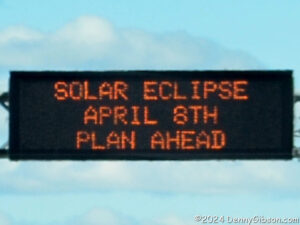 Planning is far too strong a word to describe what I have been doing since August 21, 2017, but I have certainly been looking forward to last Monday’s big event since that date. That date is, of course, when I experienced my first-ever total solar eclipse near Hopkinsville, Kentucky. Near the end of my post on that experience, I mentioned a couple of future eclipses and noted that there was “a decent chance I’ll be around in 2024”. I made it.
Planning is far too strong a word to describe what I have been doing since August 21, 2017, but I have certainly been looking forward to last Monday’s big event since that date. That date is, of course, when I experienced my first-ever total solar eclipse near Hopkinsville, Kentucky. Near the end of my post on that experience, I mentioned a couple of future eclipses and noted that there was “a decent chance I’ll be around in 2024”. I made it.

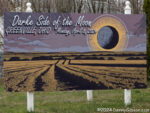 This time there was no need to leave the state or deal with unfamiliar territory to see the eclipse. 99.822% obscuration was available just outside my door and nearly four minutes of 100% obscuration less than a hundred miles north in the county of my birth. There were plenty of events large and small planned along the entire path of the eclipse but the events planned for the only Darke County in the nation may have had the best and most natural name.
This time there was no need to leave the state or deal with unfamiliar territory to see the eclipse. 99.822% obscuration was available just outside my door and nearly four minutes of 100% obscuration less than a hundred miles north in the county of my birth. There were plenty of events large and small planned along the entire path of the eclipse but the events planned for the only Darke County in the nation may have had the best and most natural name.
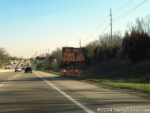 I would be viewing the eclipse from my friend Terry’s backyard just a few miles from Greenville, the county seat. I headed north pretty early in case the predicted heavy traffic actually materialized and started causing problems. I did not see much traffic but I did see evidence that it was expected. For days media of all sorts had been sharing precautions such as gassing up before heading into the anticipated congestion of the eclipse path.
I would be viewing the eclipse from my friend Terry’s backyard just a few miles from Greenville, the county seat. I headed north pretty early in case the predicted heavy traffic actually materialized and started causing problems. I did not see much traffic but I did see evidence that it was expected. For days media of all sorts had been sharing precautions such as gassing up before heading into the anticipated congestion of the eclipse path.
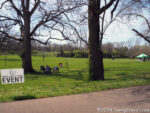

 With time to spare, Terry and I headed into town to see what we could see. Some organized events had taken place over the weekend and more were planned for Monday afternoon but it was way too early for those and there was not a carnival-like atmosphere such as I had seen in Hopkinsville in 2017. That doesn’t mean that eclipse chasers were not in town and beginning to stake out their spots. The biggest gathering of visitors was at the fairgrounds where rows of trailers and RVs belonging to members of the Wally Byam Caravan Club were parked beyond the view of my camera. Attendants guarded all the fairground entrances as well as some other open areas around town with PARKING $15 signs posted.
With time to spare, Terry and I headed into town to see what we could see. Some organized events had taken place over the weekend and more were planned for Monday afternoon but it was way too early for those and there was not a carnival-like atmosphere such as I had seen in Hopkinsville in 2017. That doesn’t mean that eclipse chasers were not in town and beginning to stake out their spots. The biggest gathering of visitors was at the fairgrounds where rows of trailers and RVs belonging to members of the Wally Byam Caravan Club were parked beyond the view of my camera. Attendants guarded all the fairground entrances as well as some other open areas around town with PARKING $15 signs posted.
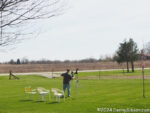 After cruising the town (which we did in abundance during our high school days) we returned to our viewing area to await the eclipse. A week ago, rain was predicted for the day. Then the prediction was mostly cloudy then partially cloudy. Eclipse day started out sunny but there were still clouds around and a partially obscured 100% obscuration remained a possibility. That did not happen and Terry, his wife Sue, and I were treated to an incredible show.
After cruising the town (which we did in abundance during our high school days) we returned to our viewing area to await the eclipse. A week ago, rain was predicted for the day. Then the prediction was mostly cloudy then partially cloudy. Eclipse day started out sunny but there were still clouds around and a partially obscured 100% obscuration remained a possibility. That did not happen and Terry, his wife Sue, and I were treated to an incredible show.

 In 2017 I wrote that it was “kind of ridiculous for me to even try photographing the eclipse” because of the many experts who were capturing and sharing photographs. I did it anyway and I did it again this year. I watched a video and did some reading about photographing the eclipse yet managed to take even worse photos in 2024 than in 2017. But I did not let it interfere with enjoying the eclipse and I am very much enjoying the marvelous photos the pros and near-pros have been sharing.
In 2017 I wrote that it was “kind of ridiculous for me to even try photographing the eclipse” because of the many experts who were capturing and sharing photographs. I did it anyway and I did it again this year. I watched a video and did some reading about photographing the eclipse yet managed to take even worse photos in 2024 than in 2017. But I did not let it interfere with enjoying the eclipse and I am very much enjoying the marvelous photos the pros and near-pros have been sharing.


 The length of totality I experienced in 2024 was nearly 50% higher than that of 2017 (159.7 vs. 235.4 seconds). The awe I felt may have been slightly different because I now had somewhat of an idea of what to expect, but it was in no way diminished. I believe that’s Venus visible to the right of the sun but I’m not certain. I also took a picture of a planet visible during totality in 2017 but I did not post it. Here it is. There was also an unused photo of the horizon taken during totality in 2017 but it is not nearly as interesting as the light on the clouds in 2024.
The length of totality I experienced in 2024 was nearly 50% higher than that of 2017 (159.7 vs. 235.4 seconds). The awe I felt may have been slightly different because I now had somewhat of an idea of what to expect, but it was in no way diminished. I believe that’s Venus visible to the right of the sun but I’m not certain. I also took a picture of a planet visible during totality in 2017 but I did not post it. Here it is. There was also an unused photo of the horizon taken during totality in 2017 but it is not nearly as interesting as the light on the clouds in 2024.
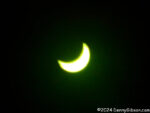 I headed home after a couple of hours and some pizza and didn’t initially find it too crowded. However, a few miles south of Dayton traffic on I-75 began to back up and I slipped off onto OH-741. I don’t know if that was a brief or long-term backup or what the cause was in either case. Traffic was flowing normally on OH-741, I easily reached home, and have my dark glasses tucked away until August 12, 2045.
I headed home after a couple of hours and some pizza and didn’t initially find it too crowded. However, a few miles south of Dayton traffic on I-75 began to back up and I slipped off onto OH-741. I don’t know if that was a brief or long-term backup or what the cause was in either case. Traffic was flowing normally on OH-741, I easily reached home, and have my dark glasses tucked away until August 12, 2045.
Trip Peek #132
Trip #73
Indiana’s Lincoln Highway
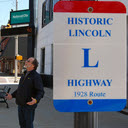 This picture is from my 2009 Indiana’s Lincoln Highway trip. I joined the Lincoln Highway Association in 2000 but had yet to attend a conference. With the 2009 conference being held in semi-near South Bend, IN, I thought I just might make it but my job got in the way. While there was still some hope of attending, I had plotted a trip on both Indiana LH alignments that I planned to wrap around the conference. When the conference was ruled out completely, I used those plans to fulfill another long-delayed ambition. A lifelong friend and I had talked of making a trip together but never quite firmed up plans. With him living near where the Lincoln Highway entered Indiana and the mid-trip conference no longer a factor, this two-way crossing of the state became a near-perfect opportunity. The picture shows my friend Dale gazing in exaggerated awe at the Kosciusko County Courthouse in Warsaw.
This picture is from my 2009 Indiana’s Lincoln Highway trip. I joined the Lincoln Highway Association in 2000 but had yet to attend a conference. With the 2009 conference being held in semi-near South Bend, IN, I thought I just might make it but my job got in the way. While there was still some hope of attending, I had plotted a trip on both Indiana LH alignments that I planned to wrap around the conference. When the conference was ruled out completely, I used those plans to fulfill another long-delayed ambition. A lifelong friend and I had talked of making a trip together but never quite firmed up plans. With him living near where the Lincoln Highway entered Indiana and the mid-trip conference no longer a factor, this two-way crossing of the state became a near-perfect opportunity. The picture shows my friend Dale gazing in exaggerated awe at the Kosciusko County Courthouse in Warsaw.
We began by driving the short distance to the state line then west through Fort Wayne where we picked up the original alignment. This took us through South Bend (about three months ahead of the conference) where we checked out the Studebaker Museum. We encountered a little snow on our second day when we finished the westbound drive and stopped at the Lincoln Highway Ideal Section just east of the Illinois line. On the third day, we drove the newer alignment eastbound between Valparaiso and Fort Wayne which includes that impressive Warsaw courthouse.
Trip Peeks are short articles published when my world is too busy or too boring for a current events piece to be completed in time for the Sunday posting. In addition to a photo thumbnail from a completed road trip, each Peek includes a brief description of that photo plus links to the full-sized photo and the associated trip journal.
A Secular Season of the Fish

Partway through last year’s Lenten season, I decided that I no longer wanted to support the Catholic (or any other) Church by patronizing their Friday Fish Fries. I explain that decision at the end of Another Season of the Fish. I still like fish and therefore still like fish fries and I am more than happy to support the many non-religious organizations that take advantage of the season by operating their own piscatorial-powered fundraisers.
Between the first and second weeks of Lent 2024, I discovered a Cincinnati Fish Fry app, similar to the one I recently used for Inaugural Cincinnati Chili Week. My unaudited count of the listed sites identified 54 churches, 16 commercial operations, and 17 others. The “others”, of course, were my targets.
I began the 2024 season at American Legion Post 513 in Mt. Healthy, Ohio, where catfish and cod were both available. I went with the catfish. This tasty meal was $11 plus $2.25 for the Yuengling draft.
The second week’s fish was a bit more expensive than last week’s but the meal included one of the biggest pieces of cod I have ever seen. Everything in the picture plus a piece of chocolate cake was $17 at Cincinnati Shriner’s.
Plans for the evening ruled out a week three fish fry dinner so I decided to do lunch at a place I’ve frequently thought of visiting in the past. This is the McDonald’s location where the first filet-o-fish sandwich was served. It is also Ohio’s first McDonald’s and my only stop at a commercial restaurant this year. Although the location was listed in the Cincinnati Fish Fry app, the app refused to let me check in here. That original filet-o-fish sold for 29¢. My tab was $9.48 but I did get fries and a drink.
My second Americal Legion visit this year was at Post 318 in Anderson Township, Ohio. The pie added $2.50 to the total. Without it, my only baked fish (cod) meal of the season would have been an even $12 including the drink (iced tea).
Week number five had me venturing across a state line to the Wilder Fire Department in Wilder, Kentucky. Fish, shrimp, and chicken were available with no options other than white or rye bread (which I declined). The entire meal, including the green (because it was almost Saint Patrick’s Day) beer and an unphotographed piece of cake with green (because… you know) icing, was $14.
For the second week in a row, I was in Kentucky and drinking Bud Light. Last week’s green Bud was only $1. This week’s yellow Bud was $2. The rest of the meal at Newport Elks Lodge #273 was $13 and it just might be the best of the year.

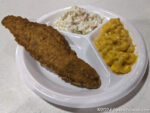 Lent officially ends on the Thursday preceding Good Friday. Many institutions wrap up their fish fry operations before the Easter weekend is reached but enough don’t to make a seven-week season of fish easily accomplished. I finished my 2024 seven-week run with this $12 meal at Gaily VFW Post 7340. Food is ordered at a central location then hand-delivered so you need to find a seat before ordering to supply a table number. A couple sitting alone welcomed me to their table. A lady in a wheelchair soon occupied the spot to my left and she was immediately greeted by several locals who were delighted to see her. I never did catch her name but learned that she was 100 years old then learned through personal experience just how peppy and friendly she was. She told me she had been coming to the post since its founding in the 1950s. I admitted that this was my first time there but promised to come back to see her next year. Now I have something to look forward to.
Lent officially ends on the Thursday preceding Good Friday. Many institutions wrap up their fish fry operations before the Easter weekend is reached but enough don’t to make a seven-week season of fish easily accomplished. I finished my 2024 seven-week run with this $12 meal at Gaily VFW Post 7340. Food is ordered at a central location then hand-delivered so you need to find a seat before ordering to supply a table number. A couple sitting alone welcomed me to their table. A lady in a wheelchair soon occupied the spot to my left and she was immediately greeted by several locals who were delighted to see her. I never did catch her name but learned that she was 100 years old then learned through personal experience just how peppy and friendly she was. She told me she had been coming to the post since its founding in the 1950s. I admitted that this was my first time there but promised to come back to see her next year. Now I have something to look forward to.
Southern Ohio Museum
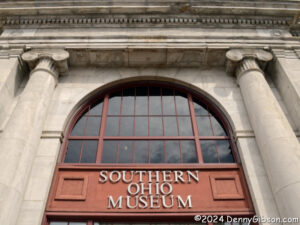 Let’s make it four. With nothing planned for the week following a string of three museum visits, my thoughts naturally turned to extending the streak. Museum visit number one was the result of an online article, number two happened because of a friend’s suggestion, and number three came from a search for “Cincinnati museums”. Thinking to extend the range along with extending the streak, I searched for “southern Ohio museums” and found not only several museums in that area but one with that exact name.
Let’s make it four. With nothing planned for the week following a string of three museum visits, my thoughts naturally turned to extending the streak. Museum visit number one was the result of an online article, number two happened because of a friend’s suggestion, and number three came from a search for “Cincinnati museums”. Thinking to extend the range along with extending the streak, I searched for “southern Ohio museums” and found not only several museums in that area but one with that exact name.
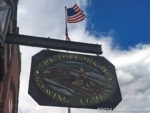
 A sunny day was all it took to get me to head to the Southern Ohio Museum in Portsmouth, Ohio. Without question, my willingness to make the two-hour drive was boosted by the fact that Portsmouth has a mighty fine brewery and an outstanding collection of Robert Dafford murals.
A sunny day was all it took to get me to head to the Southern Ohio Museum in Portsmouth, Ohio. Without question, my willingness to make the two-hour drive was boosted by the fact that Portsmouth has a mighty fine brewery and an outstanding collection of Robert Dafford murals.


 A small group of students were being given a tour of the museum’s lower gallery when I arrived and I briefly tried to eavesdrop on their guide but soon gave that up as a bad idea and headed upstairs. Here the displays are mostly semi-permanent. Many items displayed are from the museum’s permanent collection but may change from time to time. The photos are of works by Ohio artists Gretchen Stevens Cochran, Craig McDaniel, and Clarence Holbrook Carter. Everything in the museum has an Ohio connection of some sort.
A small group of students were being given a tour of the museum’s lower gallery when I arrived and I briefly tried to eavesdrop on their guide but soon gave that up as a bad idea and headed upstairs. Here the displays are mostly semi-permanent. Many items displayed are from the museum’s permanent collection but may change from time to time. The photos are of works by Ohio artists Gretchen Stevens Cochran, Craig McDaniel, and Clarence Holbrook Carter. Everything in the museum has an Ohio connection of some sort.
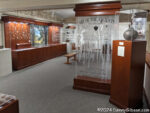
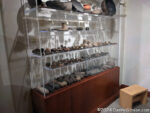
 “Art of the Ancients” is the only truly permanent exhibit in the museum. Thousands of artifacts from the Adena, Hopewell, and other indigenous cultures are displayed here. The museum occupies the former headquarters of the Security Central National Bank of Portsmouth and some of the bank’s coin-related trim can be seen in the third photo. In that same photo, Gretchen Stevens Cochran’s “Bounty or Burden” can be seen in the background.
“Art of the Ancients” is the only truly permanent exhibit in the museum. Thousands of artifacts from the Adena, Hopewell, and other indigenous cultures are displayed here. The museum occupies the former headquarters of the Security Central National Bank of Portsmouth and some of the bank’s coin-related trim can be seen in the third photo. In that same photo, Gretchen Stevens Cochran’s “Bounty or Burden” can be seen in the background.
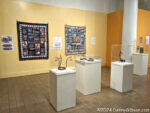 When I returned to the first floor, the students were wrapping up their tour at the far end of the gallery. This space is used for temporary exhibits and is currently occupied by “The Power of the Object“. Maureen Cadogan’s collection of objects from “the journey and experience of African American people” is augmented with several quilts made by neighbor Holly Davis. The exhibit is arranged chronologically with some of the oldest items in the collection being the slave collars in this photo.
When I returned to the first floor, the students were wrapping up their tour at the far end of the gallery. This space is used for temporary exhibits and is currently occupied by “The Power of the Object“. Maureen Cadogan’s collection of objects from “the journey and experience of African American people” is augmented with several quilts made by neighbor Holly Davis. The exhibit is arranged chronologically with some of the oldest items in the collection being the slave collars in this photo.
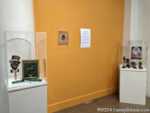
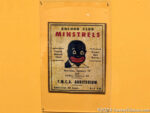 The poster on the wall in the grouping just beyond the collars really drew my interest because of some personal memories. The text beside the poster says “Though Minstrel shows gradually disappeared from professional theaters, its impact and imagery continued… well into the twentieth century.” To that, I can attest. My high school staged minstrel shows as late as 1964 or ’65. I recall two of these shows and a school yearbook indicates these were during my freshman and senior years. There is no information reported about the actual shows. The indications I refer to are individual students listing the shows among their activities. I listed participation during my freshman year only. I recall being in the chorus and a short skit but I’m sure that by the time of that second show, it had become apparent to all that my presence in any vocal group was not helpful. I have found no photos of these shows. The closest is a small picture of a parade presumedly promoting the 1964/5 show. I believe that is me carrying the bass drum.
The poster on the wall in the grouping just beyond the collars really drew my interest because of some personal memories. The text beside the poster says “Though Minstrel shows gradually disappeared from professional theaters, its impact and imagery continued… well into the twentieth century.” To that, I can attest. My high school staged minstrel shows as late as 1964 or ’65. I recall two of these shows and a school yearbook indicates these were during my freshman and senior years. There is no information reported about the actual shows. The indications I refer to are individual students listing the shows among their activities. I listed participation during my freshman year only. I recall being in the chorus and a short skit but I’m sure that by the time of that second show, it had become apparent to all that my presence in any vocal group was not helpful. I have found no photos of these shows. The closest is a small picture of a parade presumedly promoting the 1964/5 show. I believe that is me carrying the bass drum.
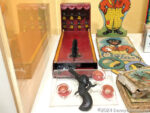
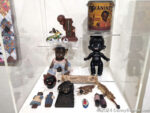
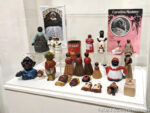 I also have some vague memories of seeing items similar to those in the mammy-themed display in the homes of relatives and friends. I have less vague memories of an alligator pencil holder like this one at my grandparents’ house. I do not have any personal memories of the toys in the third photo but a recent online discussion about a real-life version of the Baby Rack game that a friend encountered while researching amusement parks made this pressed steel version jump out at me. Brinkman Engineering Company is now Brinkman Tool & Die and no longer manufactures toys of any sort.
I also have some vague memories of seeing items similar to those in the mammy-themed display in the homes of relatives and friends. I have less vague memories of an alligator pencil holder like this one at my grandparents’ house. I do not have any personal memories of the toys in the third photo but a recent online discussion about a real-life version of the Baby Rack game that a friend encountered while researching amusement parks made this pressed steel version jump out at me. Brinkman Engineering Company is now Brinkman Tool & Die and no longer manufactures toys of any sort.
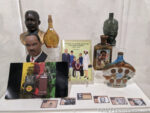
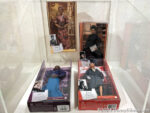 There is indeed power in these objects. They clearly can bring back memories including some that aren’t particularly welcome. It is also pretty obvious that they can make things outside our personal experience more real. Objects near the exhibit’s end provide evidence that as crappy as race relations sometimes seem, they have improved.
There is indeed power in these objects. They clearly can bring back memories including some that aren’t particularly welcome. It is also pretty obvious that they can make things outside our personal experience more real. Objects near the exhibit’s end provide evidence that as crappy as race relations sometimes seem, they have improved.
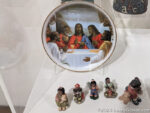 I’m sure I would have enjoyed visiting the Southern Ohio Museum regardless of what was in the temporary gallery but I’m very happy that I learned of the museum before “The Power of the Object” goes away. That will happen in just a few days, on March 27. Other exhibits will follow, of course, and I now have a reason on beyond murals and brews to visit Portsmouth.
I’m sure I would have enjoyed visiting the Southern Ohio Museum regardless of what was in the temporary gallery but I’m very happy that I learned of the museum before “The Power of the Object” goes away. That will happen in just a few days, on March 27. Other exhibits will follow, of course, and I now have a reason on beyond murals and brews to visit Portsmouth.
Greater Cincinnati Police Museum
 For the third week in a row, I’m posting about visiting a new-to-me museum. The first of the three (Small Wonders (And More)) was triggered by an online reference and the second (Miami Valley Veterans Museum) by a friend’s spontaneous suggestion but this one is completely on me. I say that I use canned posts here when my life is either too busy or too boring. My life was not too busy this week but, without some purposeful action on my part, it would have been too boring and I’d have posted something from the warehouse. That purposeful action was little more than typing “Cincinnati museums” into a search engine and scanning the results.
For the third week in a row, I’m posting about visiting a new-to-me museum. The first of the three (Small Wonders (And More)) was triggered by an online reference and the second (Miami Valley Veterans Museum) by a friend’s spontaneous suggestion but this one is completely on me. I say that I use canned posts here when my life is either too busy or too boring. My life was not too busy this week but, without some purposeful action on my part, it would have been too boring and I’d have posted something from the warehouse. That purposeful action was little more than typing “Cincinnati museums” into a search engine and scanning the results.
Quite a few lists turned up, and there were several museums that appeared on nearly all of them. One came from TripAdvisor, one of my favorite providers of crowd-sourced lists. The Greater Cincinnati Police Museum is currently number one on their list of Cincinnati Museums when sorted by “traveler ranking” and sixth when sorted by “traveler favorites”. More importantly for my purposes, it was the only top twelve entry by either sorting method that I had not visited.
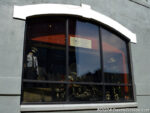 I soon corrected that and soon learned that those high marks at TripAdvisor were well deserved. The museum is on the second floor and, while things are well-marked outside, figuring that out took a little doing once inside. A sign that stood in the lobby had recently been stolen and there was universal agreement when I commented, “That sure was ballsy.” Potential issues with the free on-street parking in front of the museum are avoided by displaying a dated tag provided with admission. When I started toward the elevator with my tag, a fellow whose name I failed to get volunteered to take it down for me. I was impressed before I even looked at the first exhibit.
I soon corrected that and soon learned that those high marks at TripAdvisor were well deserved. The museum is on the second floor and, while things are well-marked outside, figuring that out took a little doing once inside. A sign that stood in the lobby had recently been stolen and there was universal agreement when I commented, “That sure was ballsy.” Potential issues with the free on-street parking in front of the museum are avoided by displaying a dated tag provided with admission. When I started toward the elevator with my tag, a fellow whose name I failed to get volunteered to take it down for me. I was impressed before I even looked at the first exhibit.
 “This is why the museum exists,” Ed, my guide, told me when we did reach that first exhibit. I had seen several pictures of Handsome over the years so had some idea of what he meant. Cincinnati’s first “police dog” was rescued from the city’s rough and tumble riverfront in the last years of the nineteenth century and served the department until his death in 1911. Handsome’s story, including numerous captures, is told here.
“This is why the museum exists,” Ed, my guide, told me when we did reach that first exhibit. I had seen several pictures of Handsome over the years so had some idea of what he meant. Cincinnati’s first “police dog” was rescued from the city’s rough and tumble riverfront in the last years of the nineteenth century and served the department until his death in 1911. Handsome’s story, including numerous captures, is told here.
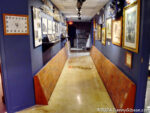 The word “Greater” in the museum’s name is significant. The museum honors not only the City of Cincinnati Police Department but many other law enforcement agencies in southern Ohio, southeast Indiana, and northern Kentucky. It first opened in 2002 on 8th Street on the west side of downtown then moved to its current Reading Road location in 2015. At the time of the move, bricks paving a walkway and inscribed with donor names were rescued and now line this hallway beneath rows of historic photos and certificates.
The word “Greater” in the museum’s name is significant. The museum honors not only the City of Cincinnati Police Department but many other law enforcement agencies in southern Ohio, southeast Indiana, and northern Kentucky. It first opened in 2002 on 8th Street on the west side of downtown then moved to its current Reading Road location in 2015. At the time of the move, bricks paving a walkway and inscribed with donor names were rescued and now line this hallway beneath rows of historic photos and certificates.
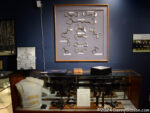
 Most if not all of the people working at the museum are retired police officers. Both Ed and Rick, who split guiding me on what was essentially a personal tour, were. Ed mentioned that he had spent a few years on a SWAT team as we looked over the associated display. Rick may have also spent time with SWAT but I don’t know that. I do know that both of these guys were pretty familiar with much of the gear on display.
Most if not all of the people working at the museum are retired police officers. Both Ed and Rick, who split guiding me on what was essentially a personal tour, were. Ed mentioned that he had spent a few years on a SWAT team as we looked over the associated display. Rick may have also spent time with SWAT but I don’t know that. I do know that both of these guys were pretty familiar with much of the gear on display.
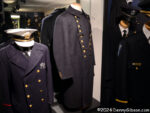
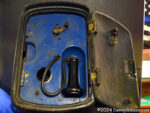 All police gear displayed in the museum is obsolete but some things are more obsolete than others. When the Civil War ended, Cincinnati was able to pick up plenty of surplus uniforms at a great price with only a change of buttons required to outfit the police. Alexander Bell patented the telephone in March of 1876. In September 1879, the first police telephone exchange in the world went live in Cincinnati.
All police gear displayed in the museum is obsolete but some things are more obsolete than others. When the Civil War ended, Cincinnati was able to pick up plenty of surplus uniforms at a great price with only a change of buttons required to outfit the police. Alexander Bell patented the telephone in March of 1876. In September 1879, the first police telephone exchange in the world went live in Cincinnati.

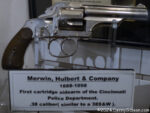 Of course, there are lots of guns (all disabled) displayed in the museum along with other tools of the trade such as breathalizers, radar guns, and fingerprinting equipment. That communication console is a little more modern than the one my cousins frequently staffed when their dad was a police chief in Indiana but looks pretty crude when compared to the multi-screened internet-connected rig that my son operates as a police dispatcher in California.
Of course, there are lots of guns (all disabled) displayed in the museum along with other tools of the trade such as breathalizers, radar guns, and fingerprinting equipment. That communication console is a little more modern than the one my cousins frequently staffed when their dad was a police chief in Indiana but looks pretty crude when compared to the multi-screened internet-connected rig that my son operates as a police dispatcher in California.
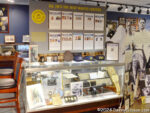 There is one notable exception to the claim that everything in the museum is obsolete. Posters for the FBI’s “Ten Most Wanted Fugitives” are kept current. Seeing them here reminded me of the days when reading these was what you did while waiting in line to buy stamps or get a package weighed. One of several reasons that they are no longer displayed is that the wall space is better used to promote the purchase of commemorative stamps and the like. The posters are still there but they are now kept in a binder behind the counter available for “on demand” viewing. Just like on the FBI website.
There is one notable exception to the claim that everything in the museum is obsolete. Posters for the FBI’s “Ten Most Wanted Fugitives” are kept current. Seeing them here reminded me of the days when reading these was what you did while waiting in line to buy stamps or get a package weighed. One of several reasons that they are no longer displayed is that the wall space is better used to promote the purchase of commemorative stamps and the like. The posters are still there but they are now kept in a binder behind the counter available for “on demand” viewing. Just like on the FBI website.
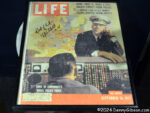 The pictured magazine is kept in protective custody but there is another copy nearby where the story of “Cincinnati’s Model Police Force” of 1957 can be accessed. The Greater Cincinnati Police Museum is open from 10:00 to 4:00 on Tuesday, Thursday, and Saturday.
The pictured magazine is kept in protective custody but there is another copy nearby where the story of “Cincinnati’s Model Police Force” of 1957 can be accessed. The Greater Cincinnati Police Museum is open from 10:00 to 4:00 on Tuesday, Thursday, and Saturday.
Book Review
Under the Catalpa Tree
Jim Grey
 Like pictures? It’s got ’em. Like variety? Got that too. There are enough pictures to fill a deck of cards or a weekly calendar, which is not accidental. The premise for the book was writing an article to accompany a photograph every week for a year. That could very well be a student assignment in an overly long writing course and in a sense it is. Jim Grey assigned himself the exercise to, as he says, “strengthen this muscle”. He is referring to the writing muscle which can surely benefit from practice just as much as a musician’s skill or an athlete’s strength.
Like pictures? It’s got ’em. Like variety? Got that too. There are enough pictures to fill a deck of cards or a weekly calendar, which is not accidental. The premise for the book was writing an article to accompany a photograph every week for a year. That could very well be a student assignment in an overly long writing course and in a sense it is. Jim Grey assigned himself the exercise to, as he says, “strengthen this muscle”. He is referring to the writing muscle which can surely benefit from practice just as much as a musician’s skill or an athlete’s strength.
 Even though photographs are at the heart of Under the Catalpa Tree, the book’s subtitle mentions only “stories and essays”. I’m guessing that is at least partially because only the stories and essays needed to be newly created for the book. The photos already existed from Grey’s many years of photographing the world around him. He doesn’t explain how the photos were selected. I am sure it was not completely random but there is tremendous variety. They range in quality from slightly fuzzy black-and-white snapshots taken years ago with a yardsale camera to crisp color images taken with high-end gear and well-developed skills. Some photos are digital but film is the source of many of the images since Grey collects — and heavily uses — film cameras. Among the subjects are family, friends, cars, houses, nature, and an abbey in Ireland.
Even though photographs are at the heart of Under the Catalpa Tree, the book’s subtitle mentions only “stories and essays”. I’m guessing that is at least partially because only the stories and essays needed to be newly created for the book. The photos already existed from Grey’s many years of photographing the world around him. He doesn’t explain how the photos were selected. I am sure it was not completely random but there is tremendous variety. They range in quality from slightly fuzzy black-and-white snapshots taken years ago with a yardsale camera to crisp color images taken with high-end gear and well-developed skills. Some photos are digital but film is the source of many of the images since Grey collects — and heavily uses — film cameras. Among the subjects are family, friends, cars, houses, nature, and an abbey in Ireland.
Of course, the subjects of those stories and essays are as varied as the subjects of the photos. Some essays are tightly tied to the photo they accompany and describe exactly how the photo came to be and the thoughts it invoked. For others, the photo is essentially a jumping-off point for some more or less unrelated observations. In both cases, the thoughts and observations tend to be rather insightful.
 A detail I appreciate is laying out the book so that all images are alone on a left-hand page. That happens naturally when the text occupies a single page, which is common, or three pages, which is not. There are quite a few two-page essays where a blank is used to get things back in synch. Totally worth it, in my opinion. Those pages, by the way, utilize Amazon’s premium paper which has the photos looking their best.
A detail I appreciate is laying out the book so that all images are alone on a left-hand page. That happens naturally when the text occupies a single page, which is common, or three pages, which is not. There are quite a few two-page essays where a blank is used to get things back in synch. Totally worth it, in my opinion. Those pages, by the way, utilize Amazon’s premium paper which has the photos looking their best.
With all the variety I have mentioned a couple of times, it is not easy to nail down a concise description of Under the Catalpa Tree. The best I can do is this: An illustrated set of glimpses of one Indiana resident’s memories and thoughts from the end of the last millennium and the beginning of this one.
Under the Catalpa Tree: And Other Stories and Essays, Jim Grey, Midnight Star Press (January 1, 2024), 8.25 x 8.25 inches, 156 pages, ISBN 979-8869992697
Available in paperback through Amazon or as a PDF direct from the author here.
Miami Valley Veterans Museum
 It was during September’s Waco Aircraft Company centennial that I first became aware of the Miami Valley Veterans Museum sitting about a hundred yards south of Historic WACO Field. My friend Terry and I attended the centennial and have talked ever since about visiting the museum. We finally got it done on Thursday. I was surprised to see a dozen or so cars in the lot when I arrived a little ahead of Terry and a little ahead of the museum’s 10:00 opening. I initially thought I might have the opening time wrong but soon realized that the cars that beat me there belonged to volunteers taking care of things inside. This place clearly has a dedicated and energetic crew. During my brief wait, I snapped the picture at right and noted that the building’s signage included the first USSF insignia I had seen in the wild.
It was during September’s Waco Aircraft Company centennial that I first became aware of the Miami Valley Veterans Museum sitting about a hundred yards south of Historic WACO Field. My friend Terry and I attended the centennial and have talked ever since about visiting the museum. We finally got it done on Thursday. I was surprised to see a dozen or so cars in the lot when I arrived a little ahead of Terry and a little ahead of the museum’s 10:00 opening. I initially thought I might have the opening time wrong but soon realized that the cars that beat me there belonged to volunteers taking care of things inside. This place clearly has a dedicated and energetic crew. During my brief wait, I snapped the picture at right and noted that the building’s signage included the first USSF insignia I had seen in the wild.
 The museum was established in 2009 and spent its early years in the Masonic Building in downtown Troy. It moved here in 2021. One of the first things encountered on entering the museum is the History in a Box series. These are portable displays that are used in presentations at schools and such. Each box represents a different period beginning with pioneer days and currently ending with the Vietnam War. Assembling a box for the Middle East conflicts is in progress.
The museum was established in 2009 and spent its early years in the Masonic Building in downtown Troy. It moved here in 2021. One of the first things encountered on entering the museum is the History in a Box series. These are portable displays that are used in presentations at schools and such. Each box represents a different period beginning with pioneer days and currently ending with the Vietnam War. Assembling a box for the Middle East conflicts is in progress.

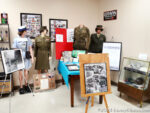 There are several other exhibits in the lobby area but the bulk of the displays are in a huge room behind it. Women are well represented throughout the museum but because March is Women’s History Month some items related to women in the military are displayed just outside the entrance to the main exhibit area. The 42-foot “Veterans Marching Through Time” mural is just inside the entrance.
There are several other exhibits in the lobby area but the bulk of the displays are in a huge room behind it. Women are well represented throughout the museum but because March is Women’s History Month some items related to women in the military are displayed just outside the entrance to the main exhibit area. The 42-foot “Veterans Marching Through Time” mural is just inside the entrance.
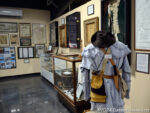
 Exhibits in the big room are arranged chronologically beginning with the pioneer period. Marine uniforms from 1776 and 1863 can be seen in the first picture. The drum visible in both pictures is from the War of 1812.
Exhibits in the big room are arranged chronologically beginning with the pioneer period. Marine uniforms from 1776 and 1863 can be seen in the first picture. The drum visible in both pictures is from the War of 1812.
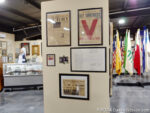
 These two photos are of more or less random items that caught my eye. The genuine “bolt action” long gun was handmade by the Viet Cong but doesn’t appear all that crude until you get close. The “ITALY SURRENDERS!” headline stood out because it is a lot more common to see headlines announcing the Japanese or German surrender. That’s quite understandable since those surrenders actually ended campaigns whereas defeating Italy was just a step on the way to victory in Europe.
These two photos are of more or less random items that caught my eye. The genuine “bolt action” long gun was handmade by the Viet Cong but doesn’t appear all that crude until you get close. The “ITALY SURRENDERS!” headline stood out because it is a lot more common to see headlines announcing the Japanese or German surrender. That’s quite understandable since those surrenders actually ended campaigns whereas defeating Italy was just a step on the way to victory in Europe.
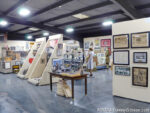 Terry and I had heard good things about the museum but it exceeded our high expectations in both the number and range of artifacts displayed. The friendliness and energy of the volunteers we met were also quite impressive. Open 10:00-2:00 Mondays, Wednesdays, and Thursdays. There is no admission charge but donations are welcomed.
Terry and I had heard good things about the museum but it exceeded our high expectations in both the number and range of artifacts displayed. The friendliness and energy of the volunteers we met were also quite impressive. Open 10:00-2:00 Mondays, Wednesdays, and Thursdays. There is no admission charge but donations are welcomed.




